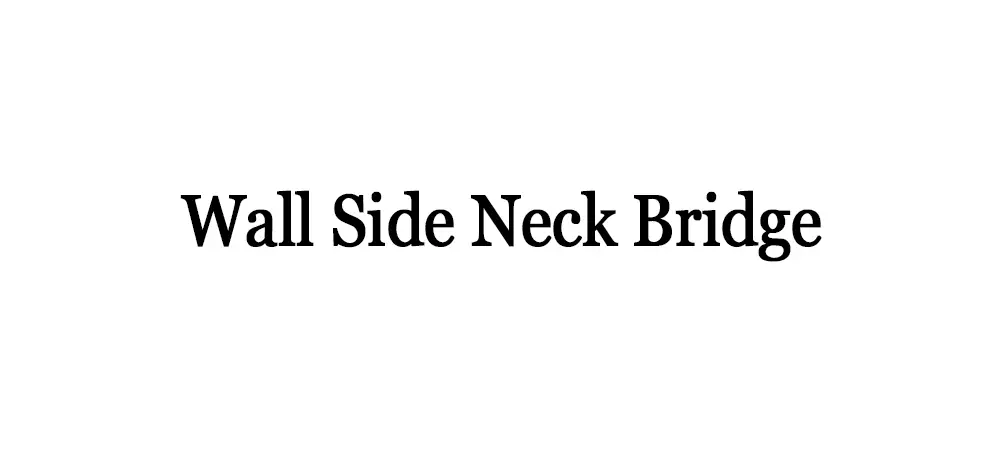Table of Contents
Introductions
The Wall Side Neck Bridge is a highly effective exercise for strengthening the neck muscles and improving cervical spine stability. This exercise, which involves supporting the body’s weight on the side of the head against a wall, targets various muscles along the neck and shoulders, including the sternocleidomastoid, scalenes, and upper trapezius. By incorporating the Wall Side Neck Bridge into your routine, you can enhance neck strength, reduce the risk of neck injuries, and improve overall neck function and stability. In this introduction, we’ll explore the proper technique, benefits, and safety considerations associated with the Wall Side Neck Bridge, empowering you to incorporate this exercise into your fitness regimen with confidence and effectiveness.
Instruction for Wall Side Neck Bridge
Here’s how to perform the Wall Side Neck Bridge exercise with proper form:
- Setup:
- Stand next to a wall with your feet hip-width apart and your side facing the wall.
- Position yourself close enough to the wall so that when you lean sideways, the side of your head can comfortably rest against it.
- Head Placement:
- Gently lean your head sideways towards the wall, allowing the side of your head to make contact with the wall. Your ear should be approximately level with your shoulder.
- Hand Placement:
- Place your hand on the same side as your head against the wall for support and stability. Your palm should be flat against the wall, and your elbow should be slightly bent.
- Bridge Position:
- While maintaining contact between the side of your head and the wall, slowly lean your body sideways away from the wall.
- Your body should form a straight line from your ankles to your head, with your shoulders, hips, and ankles stacked vertically.
- Engage your core muscles to stabilize your spine and pelvis throughout the movement.
- Hold and Return:
- Hold the bridge position for the desired duration, focusing on maintaining proper alignment and tension in the neck muscles.
- To return to the starting position, gently push yourself back towards the wall using your hand, keeping your head in contact with the wall throughout the movement.
- Repeat the exercise for the desired number of repetitions on each side.
Tips for Proper Form:
- Avoid shrugging your shoulder towards your ear during the movement. Keep your shoulder relaxed and away from your ear.
- Maintain a neutral spine throughout the exercise, avoiding excessive arching or rounding of the back.
- Perform the exercise in a slow and controlled manner, focusing on quality repetitions rather than speed.
Safety Considerations:
- Start with a conservative range of motion and gradually increase as your neck strength and flexibility improve.
- If you experience any discomfort or pain in your neck or shoulder during the exercise, stop immediately and consult with a healthcare professional.
- Ensure that the wall is clean and free from any sharp objects or rough surfaces that could cause injury to the skin or head.
Incorporate the Wall Side Neck Bridge into your routine to strengthen the muscles of the neck and improve cervical spine stability. Focus on maintaining proper form and alignment throughout the exercise for optimal safety and effectiveness.
Benefits of Wall Side Neck Bridge
The Wall Side Neck Bridge offers a range of benefits for strengthening the neck muscles and improving cervical spine stability. Here are some key benefits of incorporating this exercise into your routine:
- Neck Strength: The Wall Side Neck Bridge targets muscles along the side of the neck, including the sternocleidomastoid, scalenes, and upper trapezius. By supporting the body’s weight against gravity, this exercise effectively strengthens these muscles, promoting greater neck strength and stability.
- Improved Posture: Strong neck muscles play a crucial role in maintaining proper posture by supporting the head and neck in an upright position. Performing the Wall Side Neck Bridge regularly can help counteract the effects of prolonged sitting and forward head posture, promoting better alignment of the cervical spine.
- Reduced Neck Pain: Strengthening the neck muscles can help alleviate tension and discomfort commonly associated with neck pain. The Wall Side Neck Bridge targets muscles that may become weakened or imbalanced due to poor posture, stress, or overuse, helping to relieve strain and improve overall neck function.
- Enhanced Neck Flexibility: While primarily a strengthening exercise, the Wall Side Neck Bridge also encourages gentle stretching of the neck muscles, promoting greater flexibility and range of motion. Improved neck flexibility can help reduce stiffness and tension, allowing for smoother, more comfortable movement of the head and neck.
- Injury Prevention: By strengthening the muscles that support the neck, the Wall Side Neck Bridge can help reduce the risk of neck injuries, such as strains, sprains, and whiplash. Stronger neck muscles provide greater stability and resistance to external forces, making the neck more resilient during activities that involve sudden movements or impact.
- Functional Benefits: A strong and stable neck is essential for various daily activities, including turning the head, looking up or down, and maintaining balance during movement. The Wall Side Neck Bridge helps improve functional neck strength, making these activities easier and more comfortable to perform.
- Sports Performance: Athletes and individuals involved in sports or physical activities can benefit from the increased neck strength and stability gained through the Wall Side Neck Bridge. A stronger neck can enhance performance in sports that require rapid changes in direction, agility, and head movement.
- Mind-Body Connection: Performing the Wall Side Neck Bridge requires focus and concentration to maintain proper form and alignment. This exercise encourages mindfulness and awareness of the neck muscles, promoting a stronger mind-body connection and greater body awareness.
Incorporating the Wall Side Neck Bridge into your routine can help strengthen and stabilize the neck muscles, reduce the risk of injury, and improve overall neck health and function. As with any exercise, it’s essential to perform the Wall Side Neck Bridge with proper form and technique to maximize its benefits and minimize the risk of strain or injury.
Muscles worked in Wall Side Neck Bridge
The Wall Side Neck Bridge primarily targets the muscles along the side of the neck, also known as the lateral cervical muscles. The key muscles worked during the Wall Side Neck Bridge include:
- Sternocleidomastoid (SCM): This large muscle on each side of the neck originates from the sternum and clavicle and inserts on the mastoid process of the skull. It plays a significant role in turning and tilting the head.
- Scalenes: These muscles are located on the sides of the neck and consist of three parts: anterior, middle, and posterior. They assist in side bending of the neck and elevating the first two ribs during breathing.
- Upper Trapezius: The upper portion of the trapezius muscle, which originates from the base of the skull and inserts onto the clavicle and scapula. It assists in side bending and rotation of the neck, as well as shoulder elevation.
- Levator Scapulae: This muscle runs along the side and back of the neck, attaching to the upper cervical vertebrae and inserting onto the scapula. It helps elevate the scapula and rotate the head.
- Deep Cervical Flexors: These muscles, including the longus capitis and longus colli, are located deep within the neck and assist in flexing and stabilizing the cervical spine.
- Posterior Neck Muscles (Erector Spinae Group): While not directly targeted by the Wall Side Neck Bridge, the muscles along the back of the neck, including the splenius capitis and splenius cervicis, help stabilize and support the neck during the exercise.
During the Wall Side Neck Bridge, these muscles work together to support the weight of the head and neck against gravity while maintaining proper alignment and stability. Strengthening these muscles can help improve neck strength, stability, and posture, reducing the risk of neck pain and injury.
Alternate names of Wall Side Neck Bridge
The Wall Side Neck Bridge may also be referred to by several alternate names, including:
- Side Neck Bridge against Wall
- Wall Side Plank with Neck Rotation
- Wall Leaning Neck Exercise
- Side Head Bridge against Wall
- Lateral Neck Bridge against Wall
- Wall Side Neck Isometric Hold
- Wall Lateral Neck Strengthening Exercise
- Wall Side Head Resistance Training
- Side Neck Muscles Wall Exercise
- Wall Side Neck Stability Drill
These alternate names may be used interchangeably depending on the context or preferences of fitness professionals or practitioners. Regardless of the terminology, the exercise focuses on strengthening the lateral muscles of the neck and improving cervical spine stability.
Conclusion
In conclusion, the Wall Side Neck Bridge is a valuable exercise for strengthening the lateral muscles of the neck and enhancing cervical spine stability. By supporting the body’s weight against a wall while maintaining proper alignment, this exercise targets key muscles such as the sternocleidomastoid, scalenes, and upper trapezius. Incorporating the Wall Side Neck Bridge into your routine can lead to several benefits, including improved neck strength, reduced neck pain, enhanced posture, and decreased risk of injury.
It’s essential to perform the Wall Side Neck Bridge with proper form and technique to maximize its effectiveness and minimize the risk of strain or injury. Focus on maintaining a neutral spine, engaging the core muscles, and controlling the movement with slow and deliberate motions. Start with a conservative range of motion and gradually increase intensity as your neck strength and flexibility improve.
Overall, the Wall Side Neck Bridge offers a practical and accessible way to target the muscles of the neck and promote neck health and function. Whether you’re looking to alleviate neck pain, improve posture, or enhance athletic performance, incorporating this exercise into your routine can contribute to better overall neck strength, stability, and mobility. As always, listen to your body, and consult with a healthcare professional if you have any concerns or experience discomfort during the exercise.
FAQs of Wall Side Neck Bridge
What is the Wall Side Neck Bridge?
The Wall Side Neck Bridge is an exercise that involves supporting the body’s weight against a wall while maintaining proper alignment of the head and neck. It primarily targets the lateral muscles of the neck and helps improve neck strength and stability.
How do I perform the Wall Side Neck Bridge?
To perform the Wall Side Neck Bridge, stand next to a wall with your side facing it. Lean your head sideways against the wall, place your hand on the same side against the wall for support, and slowly lean your body sideways away from the wall while maintaining contact between your head and the wall.
What muscles does the Wall Side Neck Bridge work?
The Wall Side Neck Bridge primarily targets the lateral muscles of the neck, including the sternocleidomastoid, scalenes, and upper trapezius. It also engages the deep cervical flexors and provides some activation of the core muscles for stabilization.
What are the benefits of the Wall Side Neck Bridge?
The Wall Side Neck Bridge can help improve neck strength, reduce neck pain, enhance posture, and decrease the risk of neck injuries. It also promotes greater neck flexibility and range of motion.
How often should I do the Wall Side Neck Bridge?
The frequency of performing the Wall Side Neck Bridge can vary depending on individual fitness goals and needs. It’s generally safe to incorporate this exercise into your routine 2-3 times per week, allowing for adequate rest and recovery between sessions.
Are there any safety considerations for the Wall Side Neck Bridge?
It’s essential to perform the Wall Side Neck Bridge with proper form and technique to minimize the risk of strain or injury. Start with a conservative range of motion and gradually increase intensity as your neck strength improves. If you experience any discomfort or pain during the exercise, stop immediately and consult with a healthcare professional.
Can I modify the Wall Side Neck Bridge?
Yes, you can modify the Wall Side Neck Bridge based on your fitness level and needs. You can adjust the intensity by changing the distance from the wall or using variations such as adding resistance with a resistance band. Always prioritize proper form and listen to your body when modifying the exercise.
Who can benefit from the Wall Side Neck Bridge?
The Wall Side Neck Bridge can benefit anyone looking to improve neck strength, stability, and posture. It’s particularly beneficial for individuals experiencing neck pain, stiffness, or poor posture due to prolonged sitting or desk work. Athletes and fitness enthusiasts can also benefit from incorporating this exercise into their routine to enhance neck strength and reduce the risk of injury.
These FAQs provide a comprehensive overview of the Wall Side Neck Bridge, its benefits, and considerations for safe and effective performance. Incorporating this exercise into your routine can contribute to better overall neck health and function.
Wall Side Neck Bridge Alternate Exercises
Here are some alternate exercises that target similar muscle groups as the Wall Side Neck Bridge:
- Neck Side Flexion with Resistance Band:
- Sit or stand with good posture and hold one end of a resistance band with your hand.
- Place the other end of the band over your head, resting it on the side of your head near your ear.
- Slowly tilt your head towards the opposite shoulder against the resistance of the band, focusing on contracting the lateral muscles of the neck.
- Return to the starting position and repeat for the desired number of repetitions on each side.
- Seated Neck Lateral Flexion:
- Sit on a chair with your back straight and feet flat on the floor.
- Place one hand on the side of your head and gently tilt your head towards the same side, feeling a stretch along the opposite side of your neck.
- Hold the stretch for 15-30 seconds, then return to the starting position and repeat on the other side.
- To increase the stretch, you can gently pull your head towards the shoulder with your hand.
- Resistance Band Lateral Neck Isometrics:
- Sit or stand with good posture and hold one end of a resistance band with your hand.
- Place the other end of the band under your foot on the same side.
- With your head in a neutral position, push your head sideways against the resistance of the band, engaging the lateral muscles of the neck.
- Hold the contraction for 5-10 seconds, then release and repeat for the desired number of repetitions on each side.
- Neck Side Plank:
- Lie on your side with your legs extended and prop yourself up on your forearm, keeping your elbow directly beneath your shoulder.
- Engage your core muscles and lift your hips off the ground, creating a straight line from your head to your heels.
- Rotate your body slightly towards the ceiling and lift your top arm overhead.
- Hold the side plank position for 15-30 seconds, then switch sides and repeat.
- Cervical Isometric Holds:
- Sit or stand with good posture and place your hand on the side of your head.
- Push your head against your hand in the direction of lateral flexion, resisting the movement with your hand.
- Hold the contraction for 5-10 seconds, then release and repeat on the other side.
- Focus on engaging the lateral muscles of the neck throughout the movement.
These alternate exercises provide variations to target the lateral muscles of the neck and promote neck strength, stability, and flexibility. Incorporate them into your routine based on your preferences and fitness goals, and always prioritize proper form and technique to minimize the risk of injury.
Other Neck Exercises
Also, read The cervical myodural bridge, a review of literature and clinical implications








